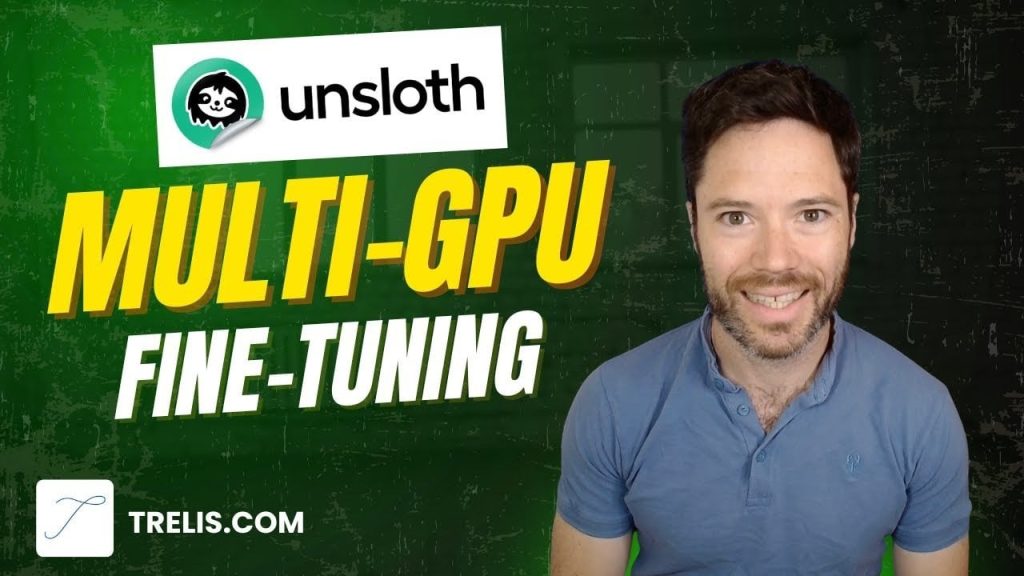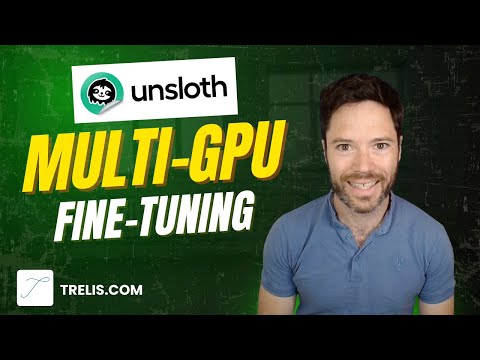What if you could train massive machine learning models in half the time without compromising performance? For researchers and developers tackling the ever-growing complexity of AI, this isn’t just a dream, it’s a necessity. Enter multi-GPU training, a innovative approach that uses Distributed Data Parallel (DDP) techniques to scale workloads across multiple GPUs. But while DDP simplifies parallelization, it’s not without its challenges, from communication bottlenecks to memory constraints. That’s where the Unsloth library comes in, offering a streamlined, high-performance alternative that’s quickly gaining traction in the AI community. Whether you’re optimizing a innovative language model or fine-tuning a smaller neural network, Unsloth promises to redefine how you approach distributed training.
In this guide, Trelis Research explain how Unsloth integrates with multi-GPU setups to deliver faster training times and improved scalability. You’ll discover how its design compares to other parallelization methods like Tensor Parallel and Pipeline Parallel, and why its simplicity makes it a standout choice for many workflows. Along the way, we’ll tackle common hurdles, like memory balancing and loss normalization, and share practical tips for configuring your environment to maximize efficiency. By the end, you’ll not only understand the mechanics of multi-GPU training with Unsloth but also gain actionable insights to supercharge your AI projects. After all, the future of AI isn’t just about building smarter models, it’s about building them faster.
Efficient Multi-GPU Training
TL;DR Key Takeaways :
- Distributed Data Parallel (DDP) is a preferred method for multi-GPU training due to its simplicity, efficiency, and lower communication overhead compared to other parallelization techniques like Tensor Parallel and Pipeline Parallel.
- The Unsloth library offers a faster alternative to the Transformers library for multi-GPU training, doubling performance in some cases, but lacks support for Fully Sharded Data Parallel (FSDP) for extremely large models.
- Setting up multi-GPU training with Unsloth involves careful configuration of GPU assignments, device mappings, and initialization routines to ensure compatibility and minimize communication bottlenecks.
- Optimizing training parameters such as batch size, gradient accumulation, and learning rate is crucial for balancing performance and resource utilization, with tools like TensorBoard aiding in monitoring and fine-tuning.
- Challenges with Unsloth, such as tensor operations and loss normalization, require manual adjustments and workarounds to maintain smooth training workflows, particularly for larger models or datasets.
Understanding Distributed Data Parallel (DDP)
Distributed Data Parallel (DDP) is a widely used method for training machine learning models across multiple GPUs. It operates by synchronizing model weights across GPUs during training, making sure consistent updates while maintaining high efficiency. DDP is particularly effective for models that fit within the memory of a single GPU, as it avoids the complexities of splitting models across devices.
Key comparisons between DDP and other parallelization techniques include:
- Tensor Parallel: Divides model layers across GPUs, requiring complex communication between devices, which can introduce latency.
- Pipeline Parallel: Processes model segments sequentially, which can lead to delays due to inter-stage dependencies.
- DDP: Distributes data across GPUs, offering simplicity and lower communication overhead for models that do not require splitting.
The simplicity and efficiency of DDP make it a preferred choice for many training scenarios, especially when paired with libraries like Unsloth that enhance its capabilities.
Why Choose the Unsloth Library?
Unsloth has gained recognition as a faster alternative to the Transformers library for multi-GPU training, offering up to twice the performance in certain scenarios. Its streamlined design simplifies the distributed training process, making it an attractive option for researchers and developers seeking to accelerate their workflows. However, it is important to note that Unsloth currently lacks support for Fully Sharded Data Parallel (FSDP), which is essential for training extremely large models.
To fully use Unsloth, converting Jupyter notebooks into Python scripts is a necessary step. This ensures compatibility with multi-GPU setups and avoids runtime issues. By adopting Unsloth, you can achieve faster training times while maintaining model accuracy, making it a valuable tool for large-scale AI projects.
Multi GPU AI Training with Unsloth Guide 2025
Enhance your knowledge on training AI models by exploring a selection of articles and guides on the subject.
Setting Up Multi-GPU Training
Configuring multi-GPU training with Unsloth requires careful planning and execution. The `accelerate` library simplifies this process by managing device mappings and environment variables. Before scaling to multiple GPUs, it is advisable to test your training scripts on a single GPU to identify and resolve potential issues. Essential steps for setup include:
- Defining GPU assignments using environment variables such as `LOCAL_RANK` to ensure proper device allocation.
- Adjusting device maps to align with your specific hardware configuration.
- Modifying initialization routines in your scripts to ensure compatibility with DDP.
Proper configuration is critical to minimizing communication bottlenecks between GPUs, which can otherwise hinder training efficiency. By addressing these aspects early, you can create a robust foundation for scaling your training workflows.
Optimizing Training Parameters
Fine-tuning large language models involves careful adjustment of training parameters to balance performance and resource utilization. Key factors to consider include:
- Batch Size: Larger batch sizes can improve throughput but require more GPU memory, necessitating a balance based on available resources.
- Gradient Accumulation: Splits updates across smaller batches, helping to manage memory constraints effectively.
- Learning Rate: Needs to be adjusted based on batch size and model architecture to ensure stable convergence.
Additionally, techniques such as gradient checkpointing can reduce memory usage by storing intermediate computations during backpropagation. Monitoring tools like TensorBoard are invaluable for tracking training progress, identifying bottlenecks, and making sure that adjustments to parameters yield the desired outcomes.
Addressing Challenges with Unsloth
While Unsloth offers significant performance advantages, it also presents unique challenges that require attention. One notable issue is its use of the `view` operation instead of `clone` for tensors, which can lead to errors in multi-GPU setups. A practical workaround involves subclassing the SFT trainer to handle batch sizes larger than one.
Another challenge is making sure proper loss normalization across GPUs. While the Transformers library is actively working on solutions, current implementations may require manual adjustments to training scripts. Addressing these challenges is essential for maintaining smooth and efficient training workflows, particularly when scaling to larger models or datasets.
Practical Steps for Multi-GPU Training
To implement multi-GPU training with Unsloth effectively, follow these steps:
- Begin by running your training script on a single GPU to verify its functionality and identify potential issues.
- Scale the script to multiple GPUs using DDP, making sure proper synchronization of model weights across devices.
- Use monitoring tools like TensorBoard to track training progress, identify bottlenecks, and optimize performance.
For debugging and optimization, focus on areas such as communication overhead, memory usage, and gradient synchronization. These factors play a crucial role in determining the overall efficiency of your training setup.
Looking Ahead: Future Developments
As of Wednesday, September 3, 2025, advancements in GPU hardware and software continue to shape the landscape of multi-GPU training. Libraries like Unsloth and Transformers are expected to address current limitations, offering enhanced support for larger models and more efficient parallelization techniques. Staying informed about these developments will enable you to use emerging technologies and maintain a competitive edge in AI research and development.
By mastering the principles and practices outlined in this guide, you can harness the full potential of multi-GPU training with Unsloth, paving the way for faster, more efficient model development.
Media Credit: Trelis Research
Latest Geeky Gadgets Deals
Disclosure: Some of our articles include affiliate links. If you buy something through one of these links, Geeky Gadgets may earn an affiliate commission. Learn about our Disclosure Policy.
(function(d, s, id) {
var js, fjs = d.getElementsByTagName(s)[0];
if (d.getElementById(id)) return;
js = d.createElement(s); js.id = id;
js.src = “//connect.facebook.net/en_US/all.js#xfbml=1&appId=215380905166741”;
fjs.parentNode.insertBefore(js, fjs);
}(document, ‘script’, ‘facebook-jssdk’));
setTimeout(function(){
!function(f,b,e,v,n,t,s)
{if(f.fbq)return;n=f.fbq=function(){n.callMethod?
n.callMethod.apply(n,arguments):n.queue.push(arguments)};
if(!f._fbq)f._fbq=n;n.push=n;n.loaded=!0;n.version=’2.0′;
n.queue=[];t=b.createElement(e);t.async=!0;
t.src=v;s=b.getElementsByTagName(e)[0];
s.parentNode.insertBefore(t,s)}(window,document,’script’,
‘https://connect.facebook.net/en_US/fbevents.js’);
fbq(‘init’, ‘1283939621625810’);
fbq(‘track’, ‘PageView’);
}, 3000);


